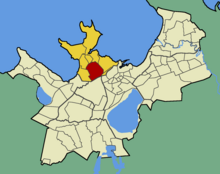Pelgulinn
Pelgulinn is a municipality ( Estonian asum ) of the Estonian capital Tallinn . It is one of the districts of the Põhja-Tallinn district ("North Tallinn").
Location, history, architecture
The district is about two kilometers northwest of the city center, across the railroad tracks near the Baltic station . The district has 14,606 inhabitants (as of 2008).
In the 18th century, the area outside of the actual city consisted mainly of meadows and forests. It was used as a hiding place by people with dubious reputations, often criminals and outcasts. Pelgulinn literally means "protective city".
At the end of the 19th century, Pelgulinn was created as a city district for workers. Many of them were busy building the rail link between Paldiski , Tallinn and the Russian capital Saint Petersburg . At the end of the 19th century a depot and a workshop for locomotives were established in Pelgulinn. As the industrialization of Tallinn progressed, more factories were added.
The image of the quarter is still characterized today by the simple, mostly two-storey workers' houses made of wood with a cellar and a loft. Numerous historicist and Art Nouveau houses from the turn of the 19th and 20th centuries have been preserved.
Pelgulinn continued to develop as a relatively green suburb in the 1920s and 1930s. In 1925 a closed block of flats was built for municipal employees. During this time, numerous double and quadruple houses were built. The Peeteli Church was built between 1936 and 1939 according to plans by the German-Estonian architect Eugen Sacharias (1906–2002).
During the Soviet occupation of Estonia, some multi-story buildings and public facilities were added to Pelgulinna's cityscape. Pelgulinn High School has existed since the 1960s. The impressive building was built in post-Stalinist style between 1958 and 1963.
literature
- Robert Nerman: Pelgulinn. Kultuurikeskkonna kujunemine ja areng. Robert Nerman Publishing House: Tallinn 2000, ISBN 9985-60-690-6 (summary in English).
Web links
- History and architecture of Pelgulinnas (Estonian)
Individual evidence
- ↑ http://www.tallinn.ee/est/g4106s43131
- ^ Estonian Architecture Museum (ed.): Tallinn in the 20th century. Architecture guide. Tallinn n.d. [1994], p. 108
- ↑ Archived copy ( memento of the original from April 20, 2008 in the Internet Archive ) Info: The archive link was inserted automatically and has not yet been checked. Please check the original and archive link according to the instructions and then remove this notice.
Coordinates: 59 ° 26 ' N , 24 ° 43' E


